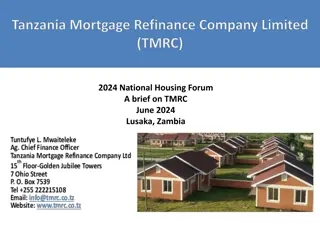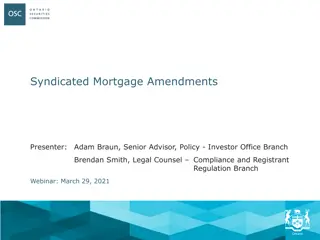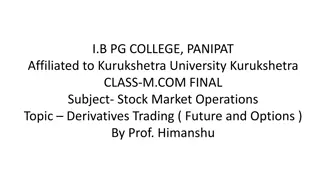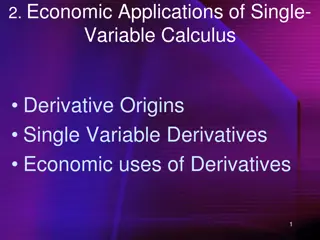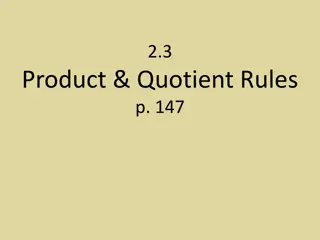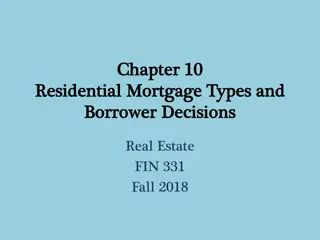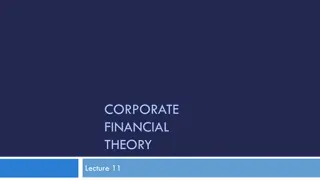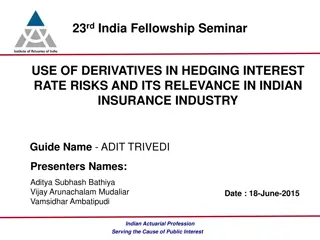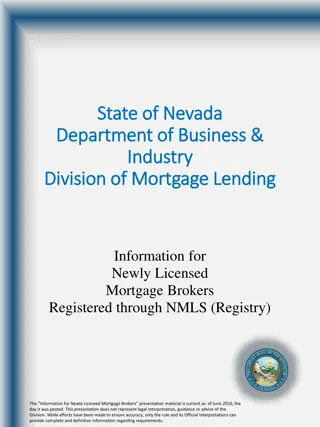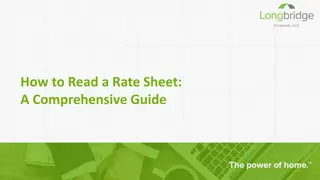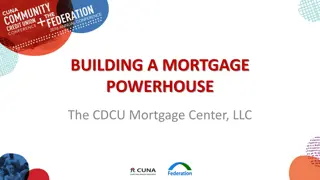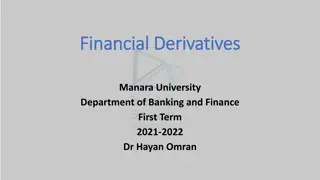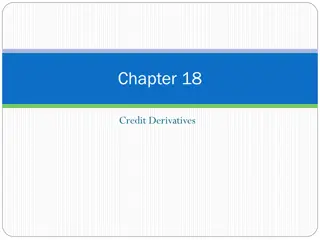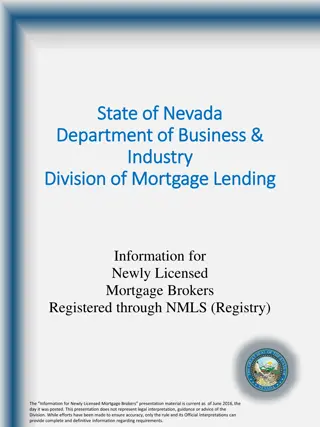Understanding Mortgage Derivatives and Risk Management
Mortgage derivatives such as Interest Only (IO) and Principal Only (PO) strips, as well as Collateralized Mortgage Obligations (CMOs), offer investors a way to manage risk more precisely than traditional mortgage-backed securities. By allowing control over interest rate and default risks, these sophisticated securities play a crucial role in the secondary mortgage markets, enhancing risk management strategies for investors.
Download Presentation

Please find below an Image/Link to download the presentation.
The content on the website is provided AS IS for your information and personal use only. It may not be sold, licensed, or shared on other websites without obtaining consent from the author. Download presentation by click this link. If you encounter any issues during the download, it is possible that the publisher has removed the file from their server.
E N D
Presentation Transcript
REAL ESTATE 410 RMBS II Spring 2017 1
Topics Mortgage derivatives Interest Only / Principal Only Structure Collateralized Mortgage Obligations Alternative CMO Structures 2
Introduction What is a derivative security? A derivative security is a security that derives its value from the value of another security, which is referred to as the underlying security. Mortgage derivative securities derive their values from the values of the underlying mortgages. MPT and MPTB can be technically viewed as mortgage derivatives. What about MBB? 3
Introduction To date we have focused on mortgage-backed bonds and mortgage pass-throughs. As noted, MPTs and MPTB are technically mortgage derivatives. However, these can be seen as first-generation MBS. These are important assets, but they are really only part of the story of the secondary mortgage markets. The second part of that story deals with the more technologically-advanced mortgage securities, i.e., mortgage derivative securities. 4
Mortgage Derivatives Three most common types of mortgage derivatives: Interest Only (IO) mortgage strips Principal Only (PO) mortgage strips Collateralized Mortgage Obligations (CMOs) Commercial Mortgage Backed Securities (CMBS) are structured similar to CMOs but are collateralized by commercial mortgages rather than home mortgages and therefore have a different risk profile 5
Mortgage Derivatives So why were these mortgage derivatives created? They allow investors to more precisely manage risk than they can with the underlying primitive security or the first- generation MBS. Remember that investors in MPTs and MPTBs will be exposed to the same risks present in the underlying mortgage pool. This is really why all derivatives, including options, futures, and forwards, exist in the first place. 6
Mortgage Derivatives IO, PO and CMOs allow investors to control much more precisely the type of interest rate risk that they want to bear. We will begin by examining IO and PO securities, and then CMOs. We will cover CMBS in the next chapter. CMBS allow investors to control much more precisely the default risk that they bear. 7
MBS and Risk Our analysis of MBS shows that changes in interest rates can affect a mortgage pool in two distinct ways: A reduction in interest rates will result in increased prepayments, causing the MBS not gaining as much value as a non-prepaying asset. An increase in interest rates causes extension (interest rate) risk. The value of the MBS drops because you discount the cash flows at a higher rate, for a longer time, due to the lack of prepayments. 8
MPT and Risk Under a normal agency MPT pool, all investors receive their proportional share of the cash flows each month. Monthly payments are collected by servicer And sent to FNMA/FHLMC. FNMA/FHLMC then distributes the payments proportionally to the investors in the MBS. More importantly, all investors bear the same types risks. It may be possible, however, to structure (i.e. design) a security that somehow carved up the cash flows so that all investors did not have the same risks. 9
IOs and POs They change cash flows that the investors were entitled to. Instead of having a single bond that all investors owned (as is the case of MPT), we can create two classes of bonds: IO Bond: The investors receive all of the interest paid each month, for the life of the bond, but none of the principal. PO Bond: The investors receive all of the principal paid each month, but none of the interest. 10
IOs and POs Now it would seem that stripping payments into IO and PO should not make that much of a difference, but it completely changes the risks that investors in each of these securities face. Remember, more prepayments results in more principal repayments and less interest payments. More importantly, this structure makes the risk very manageable for investors. 11
IOs and POs Monthly payments are collected by servicer And sent to FNMA/FHLMC. All of monthly principal and prepayments sent to the PO investor. All of monthly interest less servicing and insurance fees is sent to the IO investor. 12
IOs and POs For now, assume that we have a pool with a $1,000,000 balance and a 10% WAC. Suppose the pool backs two securities: an IO piece and a PO piece. PO holder Since you only receive principal, the total dollars that you will receive over the life of the PO is $1,000,000. You are guaranteed to (eventually) receive this cash. You will receive some principal each month. 13
IOs and and POs PO holder You will pay less than $1,000,000 to buy this PO, since the difference between what you pay and the $1,000,000 is, ultimately how you earn your return on the asset. Consider if you purchased the PO today for $600,000. The best thing that could possibly happen would be if everybody in the pool prepaid their loans next month. You would get your full $1,000,000 in one month! The worst thing that can happen is if nobody prepaid at all. 14
IOs and POs IO holder You will receive the 10% coupon on the principal, but that is it. If nobody prepaid, and the loans were outstanding for 30 years, you would receive total payments of $2,159,257. 360*8,775.72 1,000,000 = $2,159,257 On the other hand, if everybody prepaid after month 1, you would only earn the interest due for that month. 15
IOs and POs IO holder If everybody prepaid after month 1, the total cash flow from the IO investment would be: $8,333.33. 1,000,000*0.10/12 = $8,333.33 Clearly the IO investor would prefer for there to be very few prepayments. 16
IOs and POs Contrasting the risk profile of the IO and PO investments. PO Investor: Wants to recover principal as quickly as possible, so loves prepayment, loathes extension. prepayments increase when interest rates fall; you buy a PO when you expect rates to fall. PO investor bears the risk that rates will rise. It is this risk that the market is paying you to bear. 17
IOs and POs Contrasting the risk-profiles of IO and PO investments: IO Investor: Is devastated by prepayments. Wants borrowers to hold onto their loans for as long as they possibly can. A decline in interest rates will trigger a devastating wave of refinancing, destroying the value of the IO. IO investor bears the risk that rates will fall, and it is this risk that the market is paying you to bear. 18
IOs and POs Intuitively, then, you can tell something about how IOs and POs will react to interest rate changes: IOs will tend to decline in value when interest rates fall, and increase, or at least hold their value, when they rise. POs will tend to increase in value when interest rates fall and decrease in value when rates rise. The pricing of the strips and the MPT using a dynamic repayment model and assuming a return spread of 200 bps for both the IO and PO pieces will look like this. 19
IOs and POs Pricing of IO, PO, and MPT using a Dynamic Model Histograms of MBS, IO and PO, 3000 Iterations 600 500 400 Frequency 300 200 100 0 180000 230000 280000 330000 380000 430000 480000 530000 580000 630000 680000 730000 780000 830000 880000 930000 980000 1030000 1080000 Price MBS IO PO 20
IOs and POs There are several points you want to take away from this chart. The IO is generally less valuable than the PO holding the required return the same. The PO has a relatively symmetric distribution of prices, much more so than either the MBS or the IO. The IO is highly asymmetric in its distribution. We can clearly see in this how the prepayment function is radically affecting the IO value. 21
IOs and POs Effect of Interest Rates on IO, PO, and MPT Prices MBS, IO and PO Prices at Various Rates 1400000 1200000 1000000 800000 Price 600000 400000 200000 0 0 0.02 0.04 0.06 0.08 0.1 0.12 0.14 0.16 0.18 0.2 Rate MBS Price IO Price PO Price 22
IOs and POs Clearly we can see that we have segregated out the prepayment and extension risks. A person that was convinced that rates were going to go down (or that wanted to hedge against that risk) would buy the PO. A person that was convinced that rates were going to go up (or that wanted to hedge against that risk) would buy the IO. 23
IOs and POs So we can see that just by a simple reconfiguration of the cash flows already contained within the MBS into IO and PO, we are able to radically reallocate risk. Note that this is a real economic service it is not just paper pushing. An investor can select which risk, prepayment or extension, that they want to bear, and not bear the other risk. 24
IOs and POs The market is served because this structure allows a more precise allocation of risk which is the only reason a financial market exists. This makes mortgage securities palatable to investors that would otherwise never be willing to invest in them. This expands the universe of mortgage investors. This helps homebuyers because now there is now a much larger group of people that are willing to lend (indirectly) in the housing market. This lowers mortgage contract rates! 25
IOs and POs A couple of important notes. Fannie, Freddie, and Ginnie do not issue IO and PO combinations directly. An investment bank will buy the MBS (MPT) in the secondary market, and then create the IO-PO on their own. The investment bank then sells the IO and PO bonds to investors. Note that the investment bank hopes that when they sell the IO and PO separately that it will total to more than the cost to buy the MPT. In our example, we kept the return spread for the IO and the PO the same. In reality the IO is considered much riskier so it will have a higher required return. 26
Mortgage Obligations The IO and PO combination is a straightforward method for separating prepayment and extension risk that are embedded in a mortgage, but they are not the only way. In the middle to late 1980s, a number of securities dealers began to develop a type of security known as a Collateralized Mortgage Obligation, more commonly referred to by the acronym CMO, that use a different structure to allocate mortgage risks. 27
CMOs CMOs separate out the prepayment and extension risks in a very different manner from an IO and PO structure. They do it by assigning different priority of principal payments to different investors. This not only allows one to separate prepayment and extension risk, but also allows one to develop some other very innovative uses for mortgages. Generally CMOs are more flexible than are IOs and POs. 28
CMOs The basic idea behind a CMO is that we prioritize the receipt of principal among the investors. The CMO is formed by a securities dealer purchasing MBS (MPT) securities either directly from the issuer or on the open market. The dealer then creates multiple bonds (tranches) that they sell to investors. The senior tranches receive all of the principal (including prepayments) first. Once the most senior tranche is paid off, then (and only then) will the second most senior tranche be paid principal, and so on. 29
CMOs Unlike with the IO-PO combination (which you can think of as consisting of two tranches, an IO and a PO tranche), CMO tranches generally receive both interest and principal, although the timing of principal payments will depend on prepayments and of course tranche seniority. Generally all tranches receive monthly interest payments, until their principal is paid down. 30
CMOs Let s take a look at a very simple CMO structure with an underlying collateral of $100 million with a WAC of 8% and a WAM of 360 months. Four tranches, called A, B, C, and D. Each tranche is assigned $25 million of principal, with the A tranche being paid principal first, the B tranche second, the C tranche third, and the D tranche last. Each tranche is generally assigned its own coupon rate, but for now we will assume that these are all set to the same rate as the collateral. 31
CMOs The way this works, then, is that each month the principal that is received is paid to the A tranche, and its balance is reduced by the amount of the payment. Once A has been completely paid off, then B begins to receive principal, etc. Every tranche is paid interest every month. 32
CMOs Initially the A tranche receives ALL of the principal generated by the collateral. The other tranches only receive interest, based on their balance and coupon. A Tranche $25 Million MBS Collateral $100 Million B Tranche $25 Million Monthly Principal C Tranche $25 Million Monthly Interest D Tranche $25 Million 33
CMOs Once the A tranche has received $25 Million in principal, they no longer receive any cash flow, and the B tranche receives all of the principal. A Tranche $25 Million MBS Collateral Now, $75 Million B Tranche $25 Million Monthly Principal C Tranche $25 Million Monthly Interest D Tranche $25 Million 34
CMOs Similarly, once the B Tranche is paid its $25 million, it receives no more cash flows and the C tranche begins to receive its principal cash flow. A Tranche $25 Million MBS Collateral Now, $50 million B Tranche $25 Million Monthly Principal C Tranche $25 Million Monthly Interest D Tranche $25 Million 35
CMOs Finally, the C Tranche is paid off, and then the D tranche begins to receive all of the remaining principal and interest in the pool. A Tranche $25 Million MBS Collateral Now, $25 million B Tranche $25 Million Monthly Principal C Tranche $25 Million Monthly Interest D Tranche $25 Million 36
CMOs First, let s examine the cash flows that are being generated by the collateral, and then how they are broken down into payments for each of the tranches. Initially we will model the CMO assuming constant interest rates and no prepayments, but then we will relax each of those assumptions. Just to limit the number of digits we have to use, we will scale the principal amount to 100,000, instead of 100,000,000, so all amounts are in units of $1000. First, let s examine the monthly cash flows from the collateral. It will look almost exactly like a normal mortgage, with C=WAC and T=WAM. We are also going to assume no servicing initially. 37
CMOs We can calculate the monthly payment using our normal formula: ??? = $733.76 And we can then determine the interest and principal portions in month 1 in the normal ways: ???????? = 100,000 .08 12= $666.67 ????????? = 733.76 666.67 = $67.09 38
CMOs How to allocate the principal and interest to the four tranches? All of the principal goes to A, reducing its balance next period by the $67.09. The interest is allocated based on the beginning balance for each tranche, and each tranche s coupon rate (which we have made the same for all four of our tranches, 8%.) ?????????= 25,000 .08 12= $166.67 ?????????= 25,000 .08 12= $166.67 ?????????= 25,000 .08 12= $166.67 ?????????= 25,000 .08 12= $166.67 39
CMOs In month 2, we will still have the same uniform monthly payments from the pool (since we do not have prepayments in this example), but the breakdown of principal and interest is different. The balance of the collateral at the beginning of month 2 was 100,000 67.09 = $99,932.91 So the interest portion was: ???????? = 99,932.91 .08 12= $666.22 And the principal portion was ????????? = 733.76 666.22 = $67.54 40
CMOs Once again we allocate the principal by simply giving it all to Tranche A. Remember, however, that the A tranche was paid some principal in month 1, so its month 2 balance is only: ???????2= 25,000 67.09 = $24,932.91 This means that the coupon paid to Tranche A will be less than the coupon paid to Tranches B through D. ?????????= 24,932 .08 12= $166.22 ?????????= 25,000 .08 12= $166.67 ?????????= 25,000 .08 12= $166.67 ?????????= 25,000 .08 12= $166.67 41
CMOs So we can generally think of an algorithm for determining the cash flows to be: 1. Determine interest and principal paid by collateral. 2. From interest portion of collateral payment, allocate interest to each tranche based on its balance and coupon. If not enough interest from collateral, then use principal. 3. Give principal to most senior tranche remaining. If principal is more than amount owed to senior tranche, pay off senior tranche and begin to pay next-senior tranche. 42
CMOs Total Monthly Cashflow, MBS 800.00 700.00 600.00 Dollars (in Hundreds) 500.00 400.00 300.00 200.00 100.00 0.00 1 19 37 55 73 91 109 127 145 163 181 199 217 235 253 271 289 307 325 343 Month Principal Interest Remember that with no prepayments, the monthly cash flows are level, although the principal and interest proportions change by month. 43
CMOs First, let s focus only on the principal portion. MBS Principal Cash Flows 800.00 700.00 600.00 500.00 Dollars 400.00 300.00 200.00 100.00 0.00 1 19 37 55 73 91 109 127 145 163 181 199 217 235 253 271 289 307 325 343 Month 44
CMOs Principal Payments by Tranche 800.00 700.00 600.00 500.00 Amount 400.00 300.00 200.00 100.00 0.00 1 19 37 55 73 91 109 127 145 163 181 199 217 235 253 271 289 307 325 343 Month A B C D Each CMO tranche is paid its principal sequentially. Since the tranches are also paid interest each month, this leads to another set of graphs: 45
CMOs Monthly Cashflow by Tranche 800.00 700.00 600.00 500.00 Cash 400.00 300.00 200.00 100.00 0.00 1 19 37 55 73 91 109 127 145 163 181 199 217 235 253 271 289 307 325 343 Month A B C D Each tranche receives a level cash flow, until its principal begins to pay down, at which time its cash flow increases, but then stays constant until its is paid off. Let s focus on just the B Tranche. 46
CMOs Tranch B Total Payment by Month 450.00 400.00 350.00 300.00 250.00 Dollars 200.00 150.00 100.00 50.00 0.00 1 19 37 55 73 91 109 127 145 163 181 199 217 235 253 271 289 307 325 343 Month So we can see that for the first 15 years, the payment is perfectly level, followed by a dramatic jump in payment amount for roughly 8 years. 47
CMOs Tranche B Interest and Principal By Month 450.00 400.00 350.00 300.00 250.00 Dollars 200.00 150.00 100.00 50.00 0.00 1 19 37 55 73 91 109 127 145 163 181 199 217 235 253 271 289 307 325 343 Month Interest Principal If we examine the principal and interest components of the monthly payment amounts, we can see how the decline in the interest payment is exactly offset by the increase in principal payments. 48
CMOs This same general pattern holds for any sequential payment tranche like these. It is also instructive for understanding what is happening with the CMO to examine what happens to the balance of the collateral and the tranches over time. Let s begin with the overall balance of the collateral. 49
CMOs MBS Balance By Month 120000.00 100000.00 80000.00 Balance 60000.00 40000.00 20000.00 0.00 1 20 39 58 77 96 115 134 153 172 191 210 229 248 267 286 305 324 343 Month As with any FRM without prepayments, the balance has this rather familiar shape. Now, let s decompose this into the balances of the individual tranches: 50



